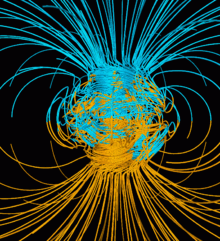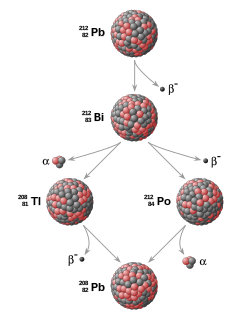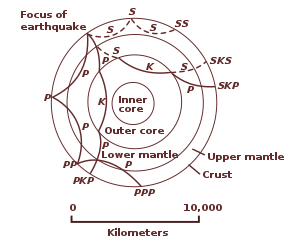Geophysics


Geophysics (
Although geophysics was only recognized as a separate discipline in the 19th century, its origins date back to ancient times. The first magnetic compasses were made from
Geophysics is applied to societal needs, such as
Physical phenomena
Geophysics is a highly interdisciplinary subject, and geophysicists contribute to every area of the
Gravity

The gravitational pull of the Moon and Sun gives rise to two high tides and two low tides every lunar day, or every 24 hours and 50 minutes. Therefore, there is a gap of 12 hours and 25 minutes between every high tide and between every low tide.[9]
Gravitational forces make rocks press down on deeper rocks, increasing their density as the depth increases.
Heat flow
The Earth is cooling, and the resulting
Vibrations

Recording of
Earthquakes pose a
Electricity
Although we mainly notice electricity during
A variety of electric methods are used in geophysical survey. Some measure
Electromagnetic waves
In the highly conductive liquid iron of the outer core, magnetic fields are generated by electric currents through electromagnetic induction.
Electromagnetic methods that are used for geophysical survey include transient electromagnetics, magnetotellurics, surface nuclear magnetic resonance and electromagnetic seabed logging.[25]
Magnetism
The Earth's magnetic field protects the Earth from the deadly

The Earth's field is roughly like a tilted
Radioactivity

Unstable isotopes decay at predictable rates, and the decay rates of different
Fluid dynamics
Geophysical fluid dynamics is a primary tool in
Waves and other phenomena in the magnetosphere can be modeled using magnetohydrodynamics.
Mineral physics
The physical properties of minerals must be understood to infer the composition of the Earth's interior from
Water is a very complex substance and its unique properties are essential for life.
The many phases of ice form the cryosphere and come in forms like ice sheets, glaciers, sea ice, freshwater ice, snow, and frozen ground (or permafrost).[36]
Regions of the Earth
Size and form of the Earth
Contrary to popular belief, the earth is not entirely spherical but instead generally exhibits an ellipsoid shape- which is a result of the centrifugal forces the planet generates due to its' constant motion.[37] These forces cause the planets diameter to bulge towards the Equator and results in the ellipsoid shape.[37] Earth's shape is constantly changing, and different factors including glacial isostatic rebound (large ice sheets melting causing the Earth's crust to the rebound due to the release of the pressure[38]), geological features such as mountains or ocean trenches, tectonic plate dynamics, and natural disasters can further distort the planet's shape.[37]
Structure of the interior

Evidence from
Reconstructions of seismic waves in the deep interior of the Earth show that there are no
Reconstruction of seismic reflections in the deep interior indicates some major discontinuities in seismic velocities that demarcate the major zones of the Earth:
The seismic model of the Earth does not by itself determine the composition of the layers. For a complete model of the Earth, mineral physics is needed to interpret seismic velocities in terms of composition. The mineral properties are temperature-dependent, so the
The mantle acts as a solid for seismic waves, but under high pressures and temperatures, it deforms so that over millions of years it acts like a liquid. This makes plate tectonics possible.
Magnetosphere

If a planet's
Methods
Geodesy
Geophysical measurements are generally at a particular time and place. Accurate measurements of position, along with earth deformation and gravity, are the province of geodesy. While geodesy and geophysics are separate fields, the two are so closely connected that many scientific organizations such as the American Geophysical Union, the Canadian Geophysical Union and the International Union of Geodesy and Geophysics encompass both.[39]
Absolute positions are most frequently determined using the
Gravity measurements became part of geodesy because they were needed to related measurements at the surface of the Earth to the reference coordinate system. Gravity measurements on land can be made using
Satellites and space probes
Satellites in space have made it possible to collect data from not only the visible light region, but in other areas of the electromagnetic spectrum. The planets can be characterized by their force fields: gravity and their magnetic fields, which are studied through geophysics and space physics.
Measuring the changes in acceleration experienced by spacecraft as they orbit has allowed fine details of the
Global positioning systems (GPS) and geographical information systems (GIS)
Since geophysics is concerned with the shape of the Earth, and by extension the mapping of features around and in the planet, geophysical measurements include high accuracy GPS measurements. These measurements are processed to increase their accuracy through differential GPS processing. Once the geophysical measurements have been processed and inverted, the interpreted results are plotted using GIS. Programs such as ArcGIS and Geosoft were built to meet these needs and include many geophysical functions that are built-in, such as upward continuation, and the calculation of the measurement derivative such as the first-vertical derivative.[11][44] Many geophysics companies have designed in-house geophysics programs that pre-date ArcGIS and GeoSoft in order to meet the visualization requirements of a geophysical dataset.
Remote sensing
Exploration geophysics is a branch of applied geophysics that involves the development and utilization of different seismic or electromagnetic methods which the aim of investigating different energy, mineral and water resources.[45] This is done through the uses of various remote sensing platforms such as; satellites, aircraft, boats, drones, borehole sensing equipment and seismic receivers. These equipment are often used in conjunction with different geophysical methods such as magnetic, gravimetry, electromagnetic, radiometric, barometry methods in order to gather the data. The remote sensing platforms used in exploration geophysics are not perfect and need adjustments done on them in order to accurately account for the effects that the platform itself may have on the collected data. For example, when gathering aeromagnetic data (aircraft gathered magnetic data) using a conventional fixed-wing aircraft- the platform has to be adjusted to account for the electromagnetic currents that it may generate as it passes through Earth's magnetic field.[11] There are also corrections related to changes in measured potential field intensity as the Earth rotates, as the Earth orbits the Sun, and as the moon orbits the Earth.[11] [44]
Signal processing
Geophysical measurements are often recorded as
History
Geophysics emerged as a separate discipline only in the 19th century, from the intersection of physical geography, geology, astronomy, meteorology, and physics.[46][47] The first known use of the word geophysics was in German ("Geophysik") by Julius Fröbel in 1834.[48] However, many geophysical phenomena – such as the Earth's magnetic field and earthquakes – have been investigated since the ancient era.
Ancient and classical eras

The magnetic compass existed in China back as far as the fourth century BC. It was used as much for feng shui as for navigation on land. It was not until good steel needles could be forged that compasses were used for navigation at sea; before that, they could not retain their magnetism long enough to be useful. The first mention of a compass in Europe was in 1190 AD.[49]
In circa 240 BC,
Perhaps the earliest contribution to seismology was the invention of a
Beginnings of modern science
The 17th century had major milestones that marked the beginning of modern science. In 1600, William Gilbert release a publication titled De Magnete (1600) where he conducted series of experiments on both natural magnets (called 'loadstones') and artificially magnetized iron.[54] His experiments lead to observations involving a small compass needle (versorium) which replicated magnetic behaviours when subjected to a spherical magnet, along with it experiencing 'magnetic dips' when it was pivoted on a horizontal axis.[54] HIs findings led to the deduction that compasses point north due to the Earth itself being a giant magnet.[54]
In 1687
The first seismometer, an instrument capable of keeping a continuous record of seismic activity, was built by James Forbes in 1844.[53]
See also
- International Union of Geodesy and Geophysics (IUGG)
- Sociedade Brasileira de Geofísica
- Earth system science – Scientific study of the Earth's spheres and their natural integrated systems
- List of geophysicists – Famous geophysicists
- Outline of geophysics – Topics in the physics of the Earth and its vicinity
- Geodynamics – Study of dynamics of the Earth
- Planetary science – Science of planets and planetary systems
- Geological Engineering
- Physics
- Space physics
- Geosciences
- Geodesy
Notes
- S2CID 15960331.
- ^ "Earth's Inconstant Magnetic Field". science@nasa. National Aeronautics and Space Administration. 29 December 2003. Retrieved 13 November 2018.
- ^ a b Sheriff 1991
- ^ a b IUGG 2011
- ^ AGU 2011
- ^ Gutenberg, B., 1929, Lehrbuch der Geophysik. Leipzig. Berlin (Gebruder Borntraeger).
- ^ Runcorn, S.K, (editor-in-chief), 1967, International dictionary of geophysics:. Pergamon, Oxford, 2 volumes, 1,728 pp., 730 fig
- ^ Geophysics, 1970, Encyclopaedia Britannica, Vol.10, p. 202-202
- ^ Ross 1995, pp. 236–242
- ^ a b c d Poirier 2000
- ^ a b c d e f g Telford, Geldart & Sheriff 1990
- ^ a b c Lowrie 2004
- ^ Davies 2001
- ^ "What is "Heat Flow"?". www.smu.edu. Retrieved 18 February 2024.
- ^ Fowler 2005
- ^ Pollack, Hurter & Johnson 1993
- ^ "Seismic wave | Earth's Interior Structure & Movement | Britannica". www.britannica.com. 12 January 2024. Retrieved 18 February 2024.
- ISBN 9780521708425.
- ^ a b Stein & Wysession 2003
- ^ Bozorgnia & Bertero 2004
- ^ a b Harrison & Carslaw 2003
- ^ Nicoll, Keri (April 2016). "Earth's electric atmosphere" (PDF). metlink.org. Retrieved 18 February 2024.
- ^ Lanzerotti & Gregori 1986
- ^ a b c d e Merrill, McElhinny & McFadden 1998
- ISBN 978-3-319-45355-2.
- ^ a b Kivelson & Russell 1995
- ^ Opdyke & Channell 1996
- ^ Turcotte & Schubert 2002
- ^ Sanders 2003
- ^ Renne, Ludwig & Karner 2000
- ^ "Radiometrics". Geoscience Australia. Commonwealth of Australia. 15 May 2014. Retrieved 23 June 2014.
- ^ "Interpreting radiometrics". Natural Resource Management. Department of Agriculture and Food, Government of Western Australia. Archived from the original on 21 March 2012. Retrieved 23 June 2014.
- ^ a b Pedlosky 1987
- ^ Sadava et al. 2009
- ^ Sirvatka 2003
- ^ CFG 2011
- ^ a b c "Is the Earth round?". oceanservice.noaa.gov. Retrieved 18 February 2024.
- ^ US Department of Commerce, National Oceanic and Atmospheric Administration. "What is glacial isostatic adjustment?". oceanservice.noaa.gov. Retrieved 18 February 2024.
- ^ a b c National Research Council (U.S.). Committee on Geodesy 1985
- ^ Defense Mapping Agency 1984
- ^ Torge 2001
- ^ CSR 2011
- ^ Muller & Sjogren 1968
- ^ a b c d Reynolds 2011
- ^ "Energy Geosciences". Jackson School of Geosciences. Retrieved 18 February 2024.
- ^ Hardy & Goodman 2005
- S2CID 122239663.
- S2CID 129513373.
- ^ Temple 2006, pp. 162–166
- ^ Russo, Lucio (2004). The Forgotten Revolution. Berlin: Springer. p. 273–277.
- ^ Eratosthenes 2010
- ^ Temple 2006, pp. 177–181
- ^ a b Dewey & Byerly 1969
- ^ a b c "Review of "De Magnete"". pwg.gsfc.nasa.gov. Retrieved 18 February 2024.
- ^ a b Smith, George (2008), "Newton's Philosophiae Naturalis Principia Mathematica", in Zalta, Edward N. (ed.), The Stanford Encyclopedia of Philosophy (Winter 2008 ed.), Metaphysics Research Lab, Stanford University, retrieved 18 February 2024
- ^ Institute of Physics (18 February 2024). "Precession of the equinoxes". Retrieved 18 February 2024.
References
- American Geophysical Union (2011). "Our Science". About AGU. Retrieved 30 September 2011.
- "About IUGG". 2011. Retrieved 30 September 2011.
- "AGUs Cryosphere Focus Group". 2011. Archived from the original on 16 November 2011. Retrieved 30 September 2011.
- Bozorgnia, Yousef; Bertero, Vitelmo V. (2004). Earthquake Engineering: From Engineering Seismology to Performance-Based Engineering. ISBN 978-0-8493-1439-1.
- Chemin, Jean-Yves; Desjardins, Benoit; ISBN 0-19-857133-X.
- Davies, Geoffrey F. (2001). Dynamic Earth: Plates, Plumes and Mantle Convection. ISBN 0-521-59067-1.
- Dewey, James; Byerly, Perry (1969). "The Early History of Seismometry (to 1900)". Bulletin of the Seismological Society of America. 59 (1): 183–227. Archived from the original on 23 November 2011.
- Defense Mapping Agency (1984) [1959]. Geodesy for the Layman (Technical report). National Geospatial-Intelligence Agency. TR 80-003. Retrieved 30 September 2011.
- Eratosthenes (2010). Eratosthenes' "Geography". Fragments collected and translated, with commentary and additional material by Duane W. Roller. ISBN 978-0-691-14267-8.
- ISBN 0-521-89307-0.
- "GRACE: Gravity Recovery and Climate Experiment". University of Texas at Austin Center for Space Research. 2011. Retrieved 30 September 2011.
- Hardy, Shaun J.; Goodman, Roy E. (2005). "Web resources in the history of geophysics". American Geophysical Union. Archived from the original on 27 April 2013. Retrieved 30 September 2011.
- Harrison, R. G.; Carslaw, K. S. (2003). "Ion-aerosol-cloud processes in the lower atmosphere". S2CID 123305218.
- Kivelson, Margaret G.; Russell, Christopher T. (1995). Introduction to Space Physics. ISBN 978-0-521-45714-9.
- Lanzerotti, Louis J.; Gregori, Giovanni P. (1986). "Telluric currents: the natural environment and interactions with man-made systems". In Geophysics Study Committee; Geophysics Research Forum; Commission on Physical Sciences, Mathematics and Resources; ISBN 0-309-03680-1.
- Lowrie, William (2004). Fundamentals of Geophysics. ISBN 0-521-46164-2.
- Merrill, Ronald T.; McElhinny, Michael W.; McFadden, Phillip L. (1998). The Magnetic Field of the Earth: Paleomagnetism, the Core, and the Deep Mantle. International Geophysics Series. Vol. 63. ISBN 978-0124912458.
- Muller, Paul; Sjogren, William (1968). "Mascons: lunar mass concentrations". S2CID 40110502.
- National Research Council (U.S.). Committee on Geodesy (1985). Geodesy: a look to the future (PDF) (Report). National Academies.
- Newton, Isaac (1999). The Principia, Mathematical principles of natural philosophy. A new translation by I Bernard Cohen and Anne Whitman, preceded by "A Guide to Newton's Principia" by I Bernard Cohen. ISBN 978-0-520-08816-0.
- Opdyke, Neil D.; Channell, James T. (1996). Magnetic Stratigraphy. ISBN 0-12-527470-X.
- Pedlosky, Joseph (1987). Geophysical Fluid Dynamics (Second ed.). ISBN 0-387-96387-1.
- Poirier, Jean-Paul (2000). Introduction to the Physics of the Earth's Interior. Cambridge Topics in Mineral Physics & Chemistry. ISBN 0-521-66313-X.
- Pollack, Henry N.; Hurter, Suzanne J.; Johnson, Jeffrey R. (1993). "Heat flow from the Earth's interior: Analysis of the global data set". .
- Renne, P.R.; Ludwig, K.R.; Karner, D.B. (2000). "Progress and challenges in geochronology". Science Progress. 83: 107–121. PMID 10800377.
- Reynolds, John M. (2011). An Introduction to Applied and Environmental Geophysics. ISBN 978-0-471-48535-3.
- Richards, M. A.; Duncan, R. A.; Courtillot, V. E. (1989). "Flood Basalts and Hot-Spot Tracks: Plume Heads and Tails". S2CID 9147772.
- Ross, D.A. (1995). Introduction to Oceanography. ISBN 0-13-491408-2.
- Sadava, David; Heller, H. Craig; Hillis, David M.; Berenbaum, May (2009). Life: The Science of Biology. ISBN 978-1-4292-1962-4.
- Sanders, Robert (10 December 2003). "Radioactive potassium may be major heat source in Earth's core". UC Berkeley News. Retrieved 28 February 2007.
- Sirvatka, Paul (2003). "Cloud Physics: Collision/Coalescence; The Bergeron Process". College of DuPage. Retrieved 31 August 2011.
- Sheriff, Robert E. (1991). "Geophysics". Encyclopedic Dictionary of Exploration Geophysics (3rd ed.). Society of Exploration. ISBN 978-1-56080-018-7.
- Stein, Seth; Wysession, Michael (2003). An introduction to seismology, earthquakes, and earth structure. ISBN 0-86542-078-5.
- Telford, William Murray; Geldart, L. P.; Sheriff, Robert E. (1990). Applied geophysics. ISBN 978-0-521-33938-4.
- Temple, Robert (2006). The Genius of China. ISBN 0-671-62028-2.
- Torge, W. (2001). Geodesy (3rd ed.). ISBN 0-89925-680-5.
- Turcotte, Donald Lawson; Schubert, Gerald (2002). Geodynamics (2nd ed.). ISBN 0-521-66624-4.
- Verhoogen, John (1980). Energetics of the Earth. ISBN 978-0-309-03076-2.
External links
- A reference manual for near-surface geophysics techniques and applications
- Commission on Geophysical Risk and Sustainability (GeoRisk), International Union of Geodesy and Geophysics (IUGG)
- Study of the Earth's Deep Interior, a Committee of IUGG
- Union Commissions (IUGG)
- USGS Geomagnetism Program
- Career crate: Seismic processor
- Society of Exploration Geophysicists

